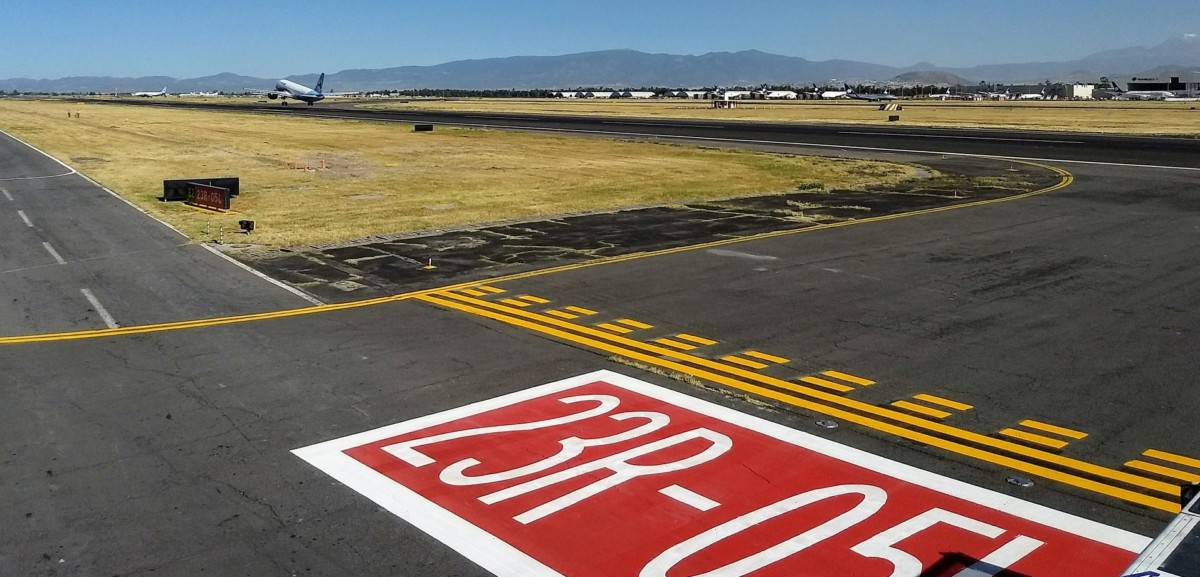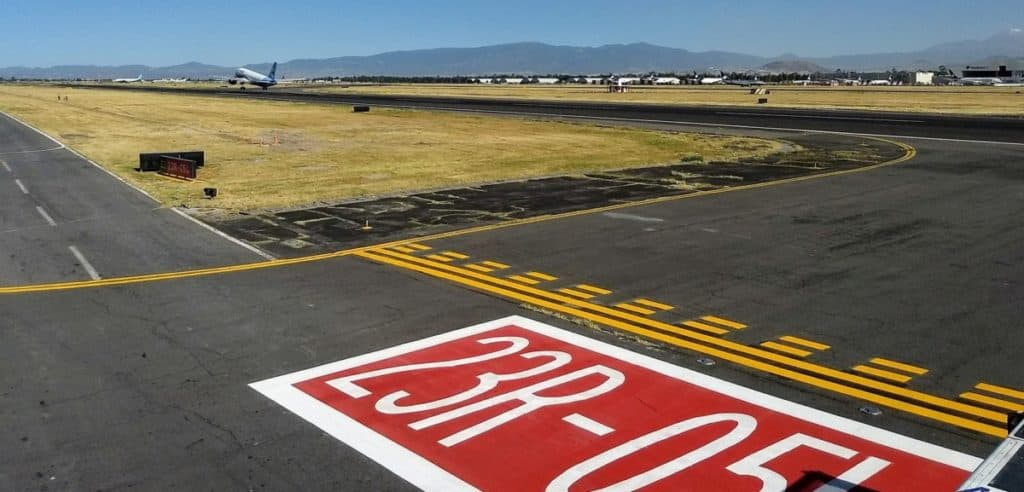
If you have ever sat in the airport terminal and looked out over the vast expanse of grass and concrete you may have wondered how the heck pilots seem to know where to go! At large international airports, it seems like a labyrinth of taxiways and runways and it boggles the mind how every pilot seems to know which way to go. The question is “How do they do that!?”
Pilots use taxi diagrams and real-time, digital moving maps to follow taxiing instructions given to them by the airport’s Ground Controller. Pilots must copy and repeat taxiing instructions verbatim and follow the instructions without deviation to ensure everyone’s safety.
Taxiing is one of the most important things a pilot learns during flight school, and it is critical to safety at an airport, no matter what aircraft they are flying. This article delves deep into just how an aircraft gets from point A to point B at an airport.
Parking to Takeoff
When the pilots are getting ready for departure one of them will call the airport Ground Controller on a prescribed radio frequency. The pilots will inform the Ground Controller of who they are and which gate they are parked at, or…
At very large international airports the pilot will first talk to an Apron Controller who will give them clearance to push back and start engines. Once the engines are started and the pilots are ready to taxi they will then be advised by the Apron Controller to switch radio frequencies to talk to the airport’s Ground Controller.
At this point, the Ground Controller will give the pilot a specific route to get them to the runway designated for departures at that time.
Landing to Parking
Once an airplane has touched down and has exited the main runway the airport’s Tower Controller will then hand that aircraft off to the airport’s Ground Controller and advise the pilot on which frequency they need to switch to and talk to Ground.
Once communication has been made with the Ground Controller the controller will issue the pilot taxiing instructions on how to get to the apron or gate required. Again, the pilot must listen and repeat this request verbatim and then follow as directed.
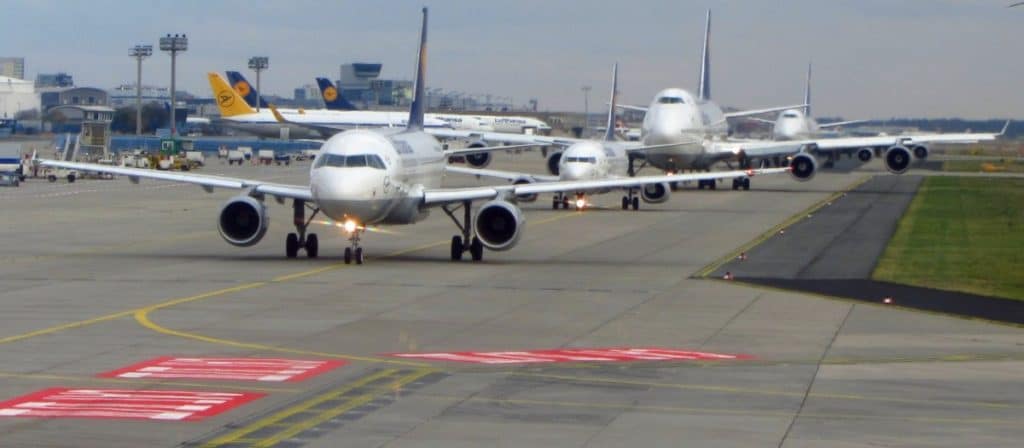
The question now remains, they now know the route to take but how do they know which is the right taxiway?
Every airport has a taxiway and runway diagram and each taxiway map is published online and kept up to date. Pilots have access to both paper and recently, digital copies. This map contains a plethora of information including:
- Taxiway names
- Runway numbers
- Any one-way directions
- High-incident locations
- Airport radio frequencies
- Apron letters
- Parking areas
- De-icing areas
The airport map below is for Istanbul Airport, which is one of the largest and busiest airports in Europe. Taxiway names are marked in Black Text on a Yellow Background.
In addition to the taxiing charts, is airport signage. Each taxiway has its own signage that matches the airport diagram. Painted lines and lighting also line each taxiway to help ensure pilots do not take the wrong turn.
As I write this article, a Turkish Airlines, Paris to Istanbul airplane (TK1826) is landing right now. This is an excellent opportunity to discuss the whole taxing process.
Learn More…
Try These Articles:
* How Long Do Airplanes Last?
* Why Do Airplanes Need to Be Towed & Pushed?
Using the Taxi Chart
The airplane has just touched down on runway 34L and is using a high-speed exit to expedite clearing the runway. Once clear of the runway the aircraft is now sat on taxiway A7B (Alpha Seven Bravo).
It is at this point the ground controller will advise them to taxi as follows:
- “TK1826 Taxi A (Alpha)
- A3 (Alpha Three)
- E (Echo)
- Hold Short B1A (Bravo One Alpha)“
After taxiing based on the above instructions the airplane is now sitting at a High-Incident area as shown by the Red Circle HS13. The pilot/s now have to advise the Ground Controller they are Holding Short on B1A as they need to cross runway 35L (L stands for Left Runway of 35). At this time the runway is active and this is as far as the ground controller has allowed the pilots to taxi by themselves. This is known as a Clearance Limit.
Once the runway is safe to cross, the ground controller will clear them to cross Runway 35L but Hold Short again on taxiway B1B because of Runway 35R (R stands for Right Runway of 35).
Again, the pilot must inform they are holding short of Runway 35R on B1B when they reach the ‘Hold Short Line’.
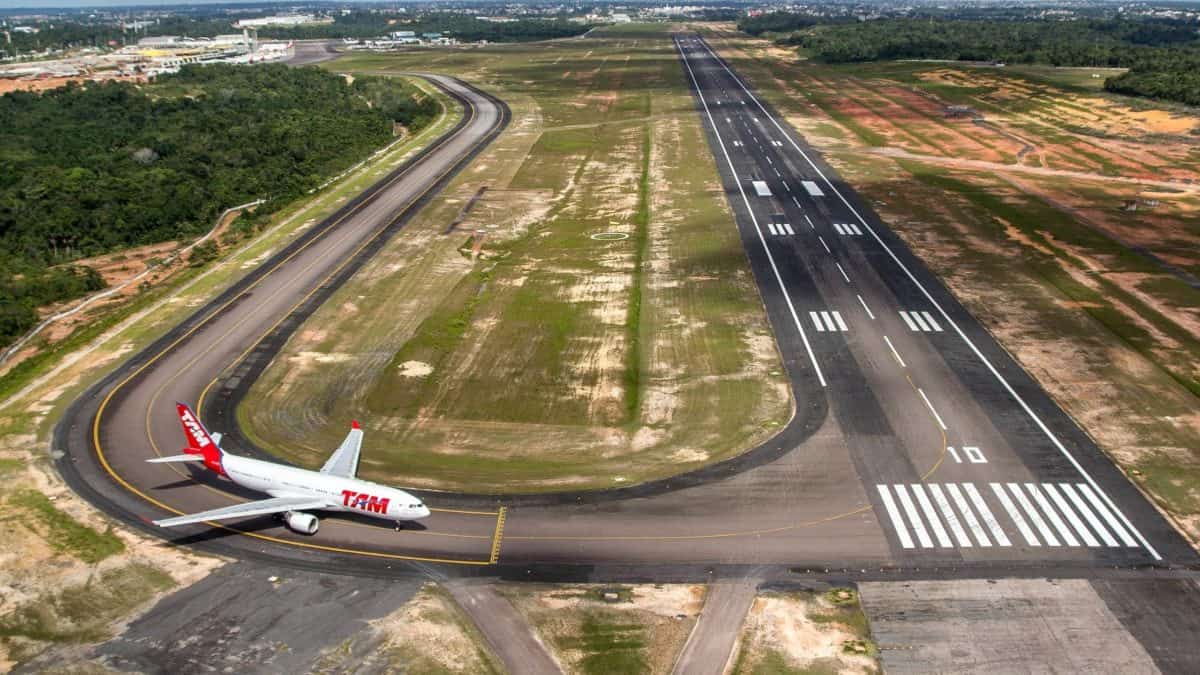
Crossing any of these Hold Short lines without clearance at best, results in a yelling at from the ground controller followed by a fine from the country’s aviation authority, to worst, causing a collision with a landing or departing aircraft.
Once it is safe, the ground controller will issue the remaining clearance and taxiing instructions to get the aircraft to the correct apron:
- “TK1826 You are Cleared To Cross Runway 35R
- Taxi C1 (Charlie One) to Terminal 2
- Contact Ground 6 on 121.675“
Each time an instruction is given the pilot must repeat it back to the controller. This allows the controller to ensure the pilot has heard and understood the instructions which really becomes important when pilots predominantly speak a foreign language.
In modern aircraft, computerized maps show the pilots exactly where they are in real time which makes taxiing so much easier. For pilots flying private aircraft, private jets, or any aircraft that does not have the included avionics, the maps can be accessed using an iPad and an aviation app like Boeing’s Foreflight.
This is a common sight in many aircraft and having personally used Foreflight for many years it truly is a godsend when at an unfamiliar airport!

Join My Newsletter & Get Great Tips, Information and Experiences To Help You Become a Superb Pilot!
Alternative Ways to Taxi Around an Airport
If a pilot is unfamiliar with an airport, he or she may request a ‘Progressive Taxi’, which means that taxi instructions are given sequentially by a ground controller who follows the aircraft and is focused on it. Busy ground controllers frown upon this as it can tie them up and distract them. Pilots should have prepared and studied the airport layout prior to arrival.
In rare cases, when fog has blanketed the airport and the visibility drops to near zero some large airports are still able to operate but on a limited schedule. To ensure airplanes can safely taxi around and not collide the airport provides a ‘Follow-Me’ car to get the aircraft around the airport.
Learn More…
Try These Articles:
* How Do Pilots Understand Air Traffic Control (ATC)?
* How Do Airplanes Not Freeze In Flight?
Airport Taxi Infrastructure
Earlier I mentioned how airports have signage, lighting, and painted markings to help pilots navigate around the airport. Each type is designed for a particular purpose:
Taxiway Signs
Just like street signs, we use to navigate in our vehicles, the airport is covered in its own ‘Street Signs’. These are known as airport signs and there are six different types:
- Mandatory Instruction Signs – These are white text on a red background
These denote critical areas or prohibited areas. Taxiways that join a runway will have these at the intersection denoting which runway is ahead. - Direction Signs – These are black text on a yellow background with an arrow
These tell the pilot the direction to get to the labeled taxiway - Information Signs – These have black text on a yellow background
Used to give pilots information like radio frequencies or noise abatement procedures - Location Signs – These are yellow text on a black background
These tell the pilot the taxiway they are currently on - Destination Signs – These are black text on a yellow background with an arrow
These direct the pilots to specific areas like the International Terminal or De-Icing area - Runway Distance Remaining Signs – These are white text on a black background
These tell the pilot how much runway remains in thousands of feet.
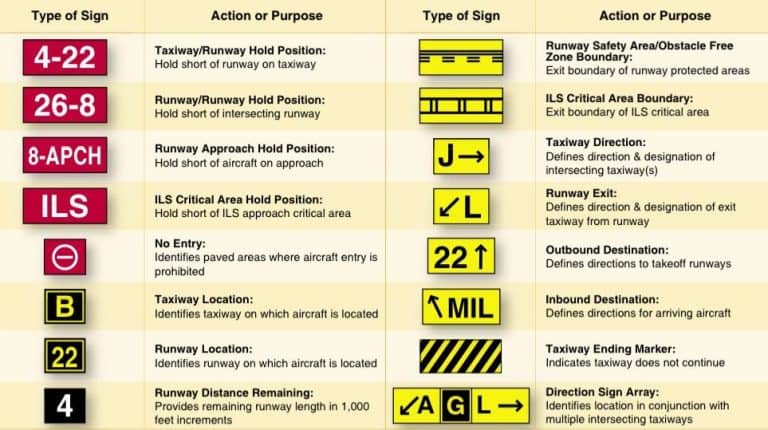
Pilots use these signs to identify where they currently are and the directions they need to turn to be on the correct taxiways assigned by the ground controller. Referencing their airport diagram to the upcoming taxiway signs is how most pilots navigate the taxiway labyrinth.
Taxiway Lighting
At night or in poor visibility conditions pilots can also use the standardized color system of the lights around the airport to help them stay on the right taxiway. All airports have a standard color system depending on where that light is located on the airport property.
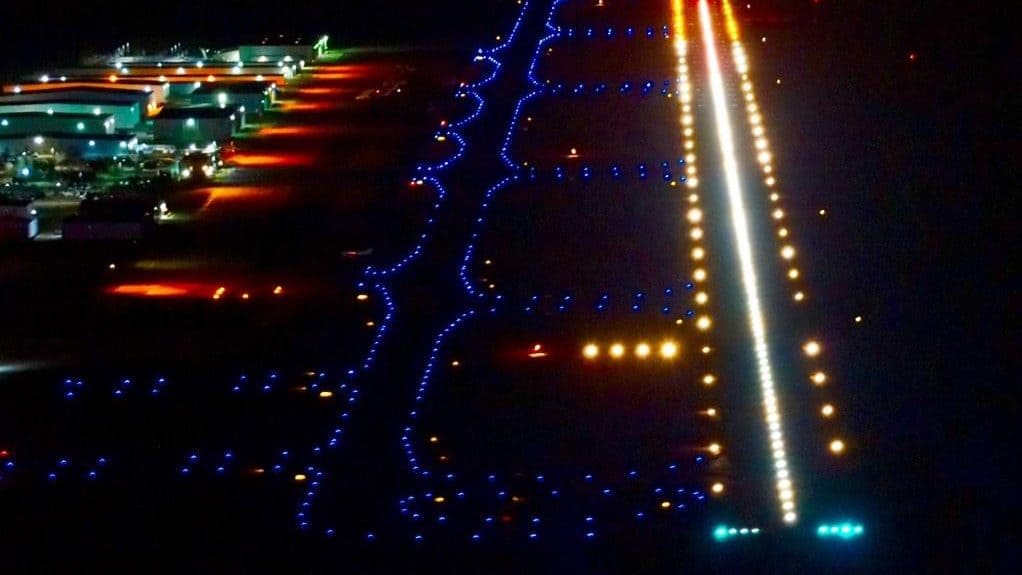
Blue Lights – These line the edge of the taxiways to ensure pilots do not taxi off the edge and onto the grass
Green Lights – These run down the center of the taxiway for the pilot to keep the aircraft centered along the taxiway
Flashing Yellow Lights – These denote the Hold Short lines before entering a runway. They flash to get the pilot’s attention
By using these lights in combination with the signs the pilots now know where to go and make sure they stay within the confines of the taxiway when visibility is reduced via darkness or weather.
Taxiway Markings
The last part of the taxiway navigation system is the painted markings on the ground. Paint is an easy way to give pilots information or direction while moving. All taxiways will have a yellow centerline. By keeping the nosewheel of the aircraft on this line it ensures the aircraft stays in the middle of the taxiway and its wings will clear other aircraft and airport obstructions.
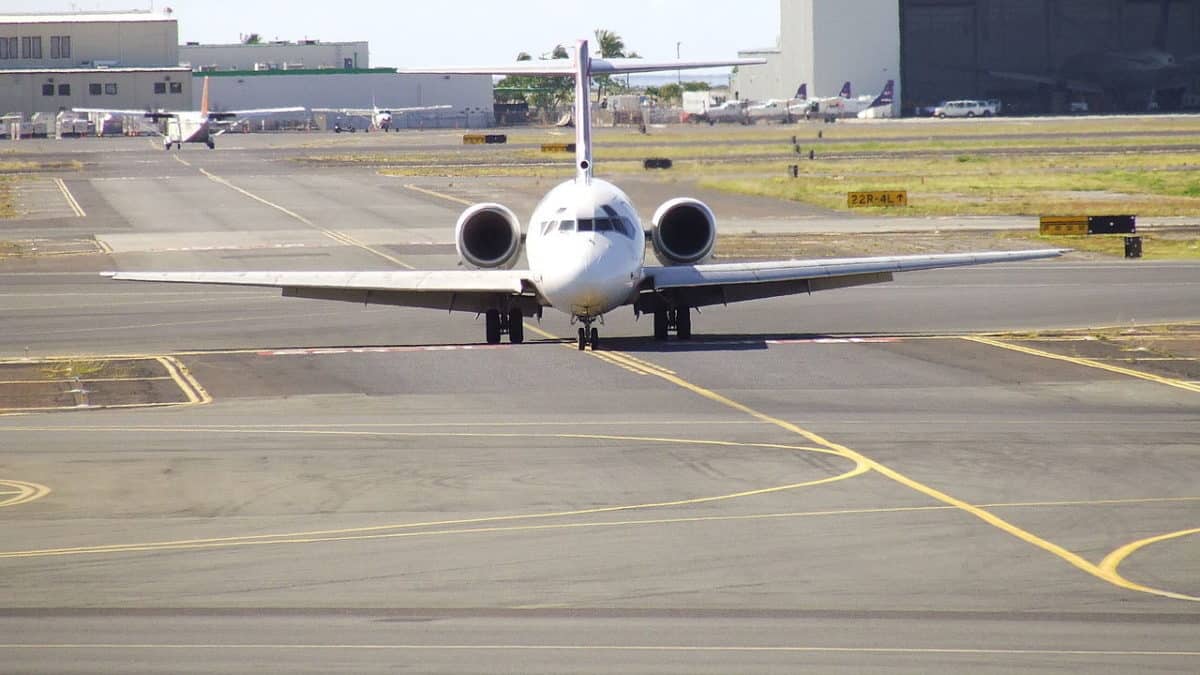
Along the edge of the taxiways are double yellow lines. These will help the pilot to see if they are about to taxi off the concrete and onto the grass by accident.
White on Red signs will be painted just before entering a runway. This ensures the pilot is about to enter the correct runway and also which direction they need to turn to be aligned for takeoff.

